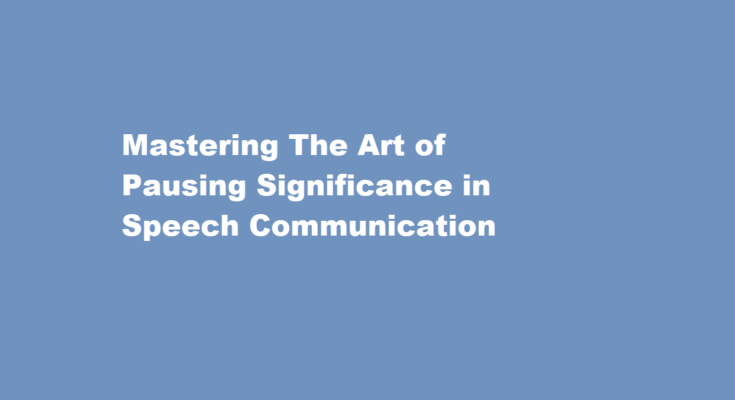Introduction
In the realm of effective communication, the power of pause often goes unnoticed, overshadowed by the allure of words and their eloquence. However, anyone who has witnessed a powerful orator in action understands the significance of a well-placed pause. These brief intermissions, when timed and executed skillfully, can transform a speech from mundane to memorable, leaving a profound impact on the audience. In this article, we will explore the art of noting a significant pause in speech and how it can enhance the effectiveness of communication.
Understanding the Purpose of Pauses
Before delving into the techniques of noting a significant pause in speech, it’s essential to understand why pauses are so crucial. Pauses serve multiple purposes in communication
- Emphasis – Pauses allow the speaker to emphasize key points or ideas. They provide the audience with a moment to digest what has been said and signal that something important is about to follow.
- Clarity – Pauses can clarify complex information or help the audience catch up, ensuring that the message is understood. This is especially important when conveying technical or intricate details.
- Engagement – Pauses can create suspense, drawing the audience in and keeping them engaged. They build anticipation for what’s to come, making the speech more captivating.
- Reflection – Pauses give both the speaker and the audience a chance to reflect on the content. This can be particularly effective when discussing thought-provoking or emotional topics.
Now that we recognize the significance of pauses, let’s explore how to note a significant pause in speech effectively.
Marking Punctuation
One of the simplest ways to note a significant pause is by using punctuation marks. In written language, we commonly use commas, periods, semicolons, and ellipses to indicate pauses. Similarly, in spoken language, you can use these same pauses to guide your audience.
- A comma (,) denotes a brief pause, often used to separate thoughts within a sentence. For instance, “We must, however, consider all the facts.”
- A period (.) indicates a complete stop, signaling the end of a thought or idea. “Our journey begins now.”
- A semicolon (;) represents a longer pause, suggesting a stronger connection between two related thoughts. “His dedication; unwavering, inspired us all.”
- Ellipses (…) convey an unfinished thought or a trailing-off, creating a sense of mystery or contemplation. “In the darkness, we found…”
Gestural Pauses
Body language plays a vital role in communication, and gestural pauses can be quite powerful. By pausing and using appropriate gestures, you can highlight a point or create anticipation. For example, raise your hand slightly while speaking and then lower it suddenly to emphasize a pause before revealing crucial information.
Vocal Inflections
Variations in tone and pitch can also be used to note a significant pause. Lowering your voice or using a dramatic pause can signal to your audience that what follows is of particular importance. This technique is often used by experienced speakers to build suspense or add emotional depth to their words.
Silence
Sometimes, the most potent pause is complete silence. Allowing a moment of silence to hang in the air can be incredibly effective. It demands the audience’s attention and creates an atmosphere of anticipation. However, it’s crucial not to overuse this technique, as prolonged silence can become uncomfortable.
Pausing for Effect
Consider pausing just before delivering a punchline, a surprising revelation, or a critical point in your speech. This pause can magnify the impact of your words, ensuring that the audience catches the significance of what you’re about to say.
Breath Control
Pausing for a breath can be a natural and effective way to note a significant pause. By taking a deep breath, you can signal a transition in your speech or emphasize a critical point. Controlled breathing also helps maintain your composure and ensures a steady pace of speech.
Scripted Pauses
In some cases, it may be beneficial to script your pauses. Indicate in your notes where you plan to pause, allowing you to stay on track during your speech. This approach can be especially helpful for beginners or when delivering a particularly important message.
Frequently Asked Questions
Why do you need to pause for a while when speaking?
When we pause at the right moments, we give our listeners the time to process what we say. We also allow our listeners to stay engaged, and this helps you to make them excited about what is to come. Pausing is also important for emphasis.
How do you indicate an important pause in the conversation?
Use long pauses (about 1½ seconds) in your speech whenever you are changing from one key idea to the next. You can separate two ‘key points’ from one another. You can also separate an example / story from the main point of the speech. This is done with paragraph size pauses before and after the example / story.
Conclusion
In the art of communication, noting a significant pause in speech is a skill that can elevate your message from ordinary to extraordinary. Pauses provide clarity, emphasis, and engagement while allowing both the speaker and the audience to reflect on the content. Whether through punctuation, gestures, vocal inflections, or controlled breathing, mastering the art of pausing is an essential tool for effective communication.
Remember that the key to effective pausing is practice. Experiment with different techniques to find what works best for you and your audience. With time and dedication, you can harness the power of pauses to captivate and inspire those who listen to your words. So, the next time you speak, remember that sometimes, silence speaks the loudest.
Read Also : Mastering The Art of Tying a Necktie A Step-by-Step Guide



